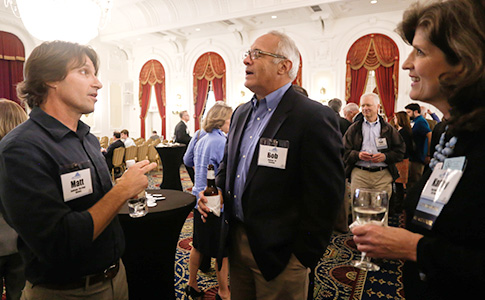Taking the Field: UNC, UVA football teams' histories illustrate sports, race issues
Posted on Oct. 23, 2014
The third day of the Virginia is for Tar Heels program dealt with football and integration.
In 1936, Carolina became the first major Southern university to go north and play football against a desegregated team. Eleven years later, the University of Virginia became the first major university in the South to host an integrated football team.
Both events were significant steps in the desegregation of college football, said Matthew Andrews ’08 (PhD), a sports historian at UNC who was the keynote speaker for the third day of the Virginia is for Tar Heels program taking place this week in five Virginia cities.
The Wednesday night event was presented at the historic Jefferson Hotel in downtown Richmond, where about 100 people gathered to hear Andrews talk about the history of race in collegiate football.
In the South, he said, “football fever really took hold,” in part because of the aftermath of the Civil War and continued for decades.
“Southern men had lost the war,” he said, “but they could redeem themselves on the football field.”
And at the time, “one thing was very clear,” he said. “White football players would not play with black players. That was absolutely forbidden.”
That was the case in 1936, when UNC President Frank Porter Graham (class of 1909) broke with tradition and let UNC play against a New York University team that put an African-American player on the field.
The decision prompted an outcry from diehard segregationists and at least one prediction that Southern society would collapse, Andrews said, but game day came and went, UNC won, and nothing happened.
Or, as civil rights activist Roy Wilkins famously said: “The University of North Carolina is still standing, and none of the young men representing it on the gridiron appears to be any worse off for having spent an afternoon competing against a Negro player.”
In a similar vein, UVA’s decision in 1947 to host a desegregated team also was a bold move, one of many at colleges and universities throughout the South that — very gradually — led to integration on the football field.
It wasn’t until 1964, Andrews noted, that UNC played against a desegregated team at Kenan Stadium, and it wasn’t until 1967 that Ricardo Lanier ’73 became UNC’s first African-American scholarship football player.
These dates left a particularly strong impression on former UNC football player Bob Duncan ’81, who said he didn’t realize how segregated the football team was a mere decade before his freshman year began.
“Think about growing up and evolving through that decade and the amazing changes that took place,” he said, “but also [think about] how far behind we were to begin with. It’s just nuts.”
Duncan played on a much more integrated team and has fond memories of being on the field with his teammates. “We were a team, and that’s a very powerful thing, being with a team where the goals are so well-defined, and you are working together toward this very clear thing. That’s a very special thing to experience.”
Others who attended the event were impressed that Andrews chose to focus on football, not basketball. “I’ve always heard of integration from a basketball perspective,” said Alison Linas ’09. “I think we all have, Dean Smith being huge in the integration movement in college athletics, but I’d never heard about it from the football perspective, so I thought it was fascinating.”
Emily Olson ’03 put it this way: “The integration of football in the South was something that was relatively new to me. I’d heard stories about an integrated Carolina team going to Death Valley at Clemson, and I’d read about the poor reception we got there in the late ’60s, but I didn’t really know the fully history. He [Andrews] really brought it alive.”
— Lucy Hood ’83
More online…
- Behind the Scenery: This GAA event in Roanoke looks at how the Blue Ridge Parkway underscores links between North Carolina and Virginia. Coverage of Virginia is for Tar Heels event on Oct. 21.
- All in the Family: At GAA event in Norfolk, one family shows Virginia is indeed for Tar Heels. Coverage of Virginia is for Tar Heels event on Oct. 20.
- Details about Virginia is for Tar Heels
- The GAA is presenting five back-to-back special evenings throughout Virginia Oct. 20-24, bringing Carolina faculty members into communities where so many UNC alumni live. For more, check the GAA’s social media channels and #VATARHEELS.
